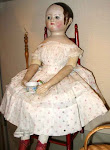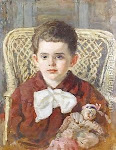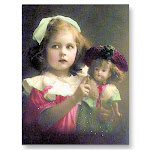The Biedermeier era refers to the historical period between the years 1815 (Congress of Vienna) the end of the Napoleonic Wars, and 1848, the year of the European Revolutions. Although the term itself is a historical reference, it is currently used to denote the artistic styles that flourished and that marked a contrast with the Romantic era which preceded it mainly in the fields of literature, music, the visual arts and interior design.
 Through out history dolls mirrored the time they were created in, their attire reflected well the haute couture of the era, and with the specially prepared plaster moulds, it made it much easier to design and create the doll’s heads with a variety of intricate hairstyles.
Through out history dolls mirrored the time they were created in, their attire reflected well the haute couture of the era, and with the specially prepared plaster moulds, it made it much easier to design and create the doll’s heads with a variety of intricate hairstyles.


 Brown was the color most commonly used on the dolls’ hair until 1820’s, and later black was preferred. A combination of real hair and modeled hair was often used as well.
Brown was the color most commonly used on the dolls’ hair until 1820’s, and later black was preferred. A combination of real hair and modeled hair was often used as well.


 The hairstyle changed dramatically. Now large bundles of side curls and complicated braided or weaved knots were seen. A large comb placed behind the knot helped stabilize the pompous hairstyle. This is the time of the classic Apollo Knot. A “coiffeur” was needed for these extravagant hairstyles, particularly when a social event was at hand.
The hairstyle changed dramatically. Now large bundles of side curls and complicated braided or weaved knots were seen. A large comb placed behind the knot helped stabilize the pompous hairstyle. This is the time of the classic Apollo Knot. A “coiffeur” was needed for these extravagant hairstyles, particularly when a social event was at hand.
 Through out history dolls mirrored the time they were created in, their attire reflected well the haute couture of the era, and with the specially prepared plaster moulds, it made it much easier to design and create the doll’s heads with a variety of intricate hairstyles.
Through out history dolls mirrored the time they were created in, their attire reflected well the haute couture of the era, and with the specially prepared plaster moulds, it made it much easier to design and create the doll’s heads with a variety of intricate hairstyles.


 Brown was the color most commonly used on the dolls’ hair until 1820’s, and later black was preferred. A combination of real hair and modeled hair was often used as well.
Brown was the color most commonly used on the dolls’ hair until 1820’s, and later black was preferred. A combination of real hair and modeled hair was often used as well.


 The hairstyle changed dramatically. Now large bundles of side curls and complicated braided or weaved knots were seen. A large comb placed behind the knot helped stabilize the pompous hairstyle. This is the time of the classic Apollo Knot. A “coiffeur” was needed for these extravagant hairstyles, particularly when a social event was at hand.
The hairstyle changed dramatically. Now large bundles of side curls and complicated braided or weaved knots were seen. A large comb placed behind the knot helped stabilize the pompous hairstyle. This is the time of the classic Apollo Knot. A “coiffeur” was needed for these extravagant hairstyles, particularly when a social event was at hand.
Dixon and Langley collection.


 After 1836 the hairstyle became plainer. Now the hair was worn with middle parting and plaited at the sides and wound around the ears to the top hair knot.. The look was charming and gracious. This was the Queen Victoria hairstyle, the prototype of many women. After her inauguration in 1837 it was very “chic” to wear ones hair like the Queen.
After 1836 the hairstyle became plainer. Now the hair was worn with middle parting and plaited at the sides and wound around the ears to the top hair knot.. The look was charming and gracious. This was the Queen Victoria hairstyle, the prototype of many women. After her inauguration in 1837 it was very “chic” to wear ones hair like the Queen.

 A time of marked changes in fashions and hairstyles...
A time of marked changes in fashions and hairstyles...
 "Day Dress" from mid 19th century..Notice beautiful shirred effect on sleeves and bodice.
"Day Dress" from mid 19th century..Notice beautiful shirred effect on sleeves and bodice.
 Fashion of this time gradually changed to lowered waistlines. As the waistline descended, the corset re appeared, shaping the bodies of women and young girls everywhere. The sleeves changed dramatically, becoming wider and extravagant this was the time of the “ Leg o’ Mutton” sleeve, eventually so enormous, they had to be supported by a fish bone framework.
Fashion of this time gradually changed to lowered waistlines. As the waistline descended, the corset re appeared, shaping the bodies of women and young girls everywhere. The sleeves changed dramatically, becoming wider and extravagant this was the time of the “ Leg o’ Mutton” sleeve, eventually so enormous, they had to be supported by a fish bone framework.
Skirts were gathered at the waist and supported with petticoats or crinolines.


 After 1836 the hairstyle became plainer. Now the hair was worn with middle parting and plaited at the sides and wound around the ears to the top hair knot.. The look was charming and gracious. This was the Queen Victoria hairstyle, the prototype of many women. After her inauguration in 1837 it was very “chic” to wear ones hair like the Queen.
After 1836 the hairstyle became plainer. Now the hair was worn with middle parting and plaited at the sides and wound around the ears to the top hair knot.. The look was charming and gracious. This was the Queen Victoria hairstyle, the prototype of many women. After her inauguration in 1837 it was very “chic” to wear ones hair like the Queen.

 A time of marked changes in fashions and hairstyles...
A time of marked changes in fashions and hairstyles...
 "Day Dress" from mid 19th century..Notice beautiful shirred effect on sleeves and bodice.
"Day Dress" from mid 19th century..Notice beautiful shirred effect on sleeves and bodice.
 Fashion of this time gradually changed to lowered waistlines. As the waistline descended, the corset re appeared, shaping the bodies of women and young girls everywhere. The sleeves changed dramatically, becoming wider and extravagant this was the time of the “ Leg o’ Mutton” sleeve, eventually so enormous, they had to be supported by a fish bone framework.
Fashion of this time gradually changed to lowered waistlines. As the waistline descended, the corset re appeared, shaping the bodies of women and young girls everywhere. The sleeves changed dramatically, becoming wider and extravagant this was the time of the “ Leg o’ Mutton” sleeve, eventually so enormous, they had to be supported by a fish bone framework.
Skirts were gathered at the waist and supported with petticoats or crinolines.
Biedermeier Period Fashions for Men.....

 The Biedermeier period (Regency period in England) was one of the great periods of male fashion. Men wore close fitting dress coats or evening coats, top hats, and colored waist coats. At the time, some men even wore corsets to achieve the perfect figure. A gentleman was always seen wearing the best attire, whether it was a wool evening tail coat or a double breasted suit with a charming top hat.
The Biedermeier period (Regency period in England) was one of the great periods of male fashion. Men wore close fitting dress coats or evening coats, top hats, and colored waist coats. At the time, some men even wore corsets to achieve the perfect figure. A gentleman was always seen wearing the best attire, whether it was a wool evening tail coat or a double breasted suit with a charming top hat.
During the early Bierdemeier period, suits sported wide lapels, and white shirts were worn with stiffened collars high above the neck. Not until 1840 the collars were worn down with shirts made of linen or muslin, topped with a silk or wool vest.

 Carl Gustav Biedermeier? He is the doll gentleman in the Doll and Toy Museum Rothenburg.
Carl Gustav Biedermeier? He is the doll gentleman in the Doll and Toy Museum Rothenburg.

At the turn of the nineteenth century, women wore thin gauzy outer dresses while men adopted trousers and overcoats...
*************************************************************
The description Biedermeier is sometimes applied to papier mache dolls with a black painted dot as the suggestion of a hairstyle on a plain egg-shaped skull common in the mid 19th century. Another is to describe almost any china doll form the same era. A collector’s theory is that a decorator usually painted on hair, but in the case of dolls that were to be wigged, he simply painted a circle on top of the head to indicate that the decorating was complete. Thus the use of this term has become very misleading. Most correctly is to use the term simply to refer to the years 1815-48... Constance Eileen King
This Victorian "genre" painting depicts a Regency (early 19th-century) young lady delighted at being the focus of attention of two rival "beaux" (handsome potential suitors), and even seeming to enjoy playing them off against each other.

 The Biedermeier period (Regency period in England) was one of the great periods of male fashion. Men wore close fitting dress coats or evening coats, top hats, and colored waist coats. At the time, some men even wore corsets to achieve the perfect figure. A gentleman was always seen wearing the best attire, whether it was a wool evening tail coat or a double breasted suit with a charming top hat.
The Biedermeier period (Regency period in England) was one of the great periods of male fashion. Men wore close fitting dress coats or evening coats, top hats, and colored waist coats. At the time, some men even wore corsets to achieve the perfect figure. A gentleman was always seen wearing the best attire, whether it was a wool evening tail coat or a double breasted suit with a charming top hat.
During the early Bierdemeier period, suits sported wide lapels, and white shirts were worn with stiffened collars high above the neck. Not until 1840 the collars were worn down with shirts made of linen or muslin, topped with a silk or wool vest.

 Carl Gustav Biedermeier? He is the doll gentleman in the Doll and Toy Museum Rothenburg.
Carl Gustav Biedermeier? He is the doll gentleman in the Doll and Toy Museum Rothenburg.

At the turn of the nineteenth century, women wore thin gauzy outer dresses while men adopted trousers and overcoats...
*************************************************************
The description Biedermeier is sometimes applied to papier mache dolls with a black painted dot as the suggestion of a hairstyle on a plain egg-shaped skull common in the mid 19th century. Another is to describe almost any china doll form the same era. A collector’s theory is that a decorator usually painted on hair, but in the case of dolls that were to be wigged, he simply painted a circle on top of the head to indicate that the decorating was complete. Thus the use of this term has become very misleading. Most correctly is to use the term simply to refer to the years 1815-48... Constance Eileen King













































.jpg)






































































Thank you for your comments on my blog. I went right to your own blog and I am amazed. The post was wonderful and I enjoyed it so much.
ReplyDeleteIt seems we share many likes. I love the Civil War period. I love antique dolls and clothing.
I love antique jewelry, furniture, and whatever else is left of that time.
I could easily move back into that time. Also love Jane Austen. I could go on and on.
But just to end with this, your post is beautiful and informative.
You asked if I sell antique dolls in my store and the answer is yes, but I also collect these so I take first what I like. Advantage of owning a store.
Thanks for writing and letting me know of your blog.
Lois
Hi Marta, Thank You for your vist today. That is a great post and a lot of information. I also do like dolls and fashion history. I found your post quite intreastin. Thanks for shareing...Julian
ReplyDeletees estupendo!!!, un periodo un poco olvidado, pero a mi me gusta tambien tanto como el victoriano....me llevo la imagen de los novios por si me atrevo a intentar hacer el vestido de novia, gracias
ReplyDeletebesos
Xisca
Thank you so much Lois and Julian. I am delighted you visited, and so thrilled you liked my blog and are following it. I love the research and collecting all the pictures, and is very rewarding when I get res ponses like yours. Many hugs
ReplyDeleteMarta
Thank you dear Xisca! I love this period so much, the hairstyles were wild to say the least. But Oh..those Milliner's Dolls! such delicate craftmanship and the couture just magnificent.
ReplyDeleteI hope you make the bride dress, I'd love to see it on one of your wonderful dolls.
Bisous
Marta
Another beautiful post, Marta. Such fun! I recall seeing in the film Wives & Daughters" a scene where the ladies were creating their hair attachments to apply to their own hair, because otherwise it would have been almost impossible to have some of the amazing designs made from the hair on one's head.
ReplyDeleteIt is nice to meet you, Marta. Your blog is just fascinating. Have a nice weekend. Twyla
ReplyDeleteMarta ... Ein wunderschöner Blog. WENN ich überhaupt Puppen mag, sterben Dann Alten und sterben Kann man hier Auf Standards eingehalten Blog bewundern.
ReplyDeleteIch bin Sammler Eher Ein von Altem Spielzeug und überwiegend alten Steifftieren. Allerdings besitze ich drei Puppen Auch ... Eine von Simon und Halbig, Ein Großer Junge in Original Kleidung und sogar den alten Original-Lederschuhen, Dann Habe ich Ältere Eine Porzellan-und Puppenhauspuppe Eine alte Kramerpuppe aus Holz im Original Kleidung. Und da NOCH KOMMEN Dann sehr viele kleine Püppchen von Schildkröt und älteren Anderen Herstellern. Gehört halt zu Altem Auch Spielzeug.
Und ICH HABE Vier Grosse historische Puppenstuben ... Eine Küche von 1910, EINEN Kaufladen von 1930, EINEN Kaufladen von 1900 und EINEN Grossen Stall mit schönen alten Tieren, Heuwagen und Einems Einer ganzen Familie.
Also, Nonne ich mal schluß machen ... so EINEN Langen Kommentar Habe ich NOCH dh GESCHRIEBEN. Hat mich gefreut, SiE kennenzulernen. Auch ich Werde Öfter vorbeischauen Nonne.
Ganz liebe Grüße von Puno / Monika
Thank you to all my friends and followers.I love your commentaries, you are all so kind.
ReplyDeleteThank you with all my heart
Bisous
Marta
Liebe Monika,
ReplyDeleteVielen Dank für Ihre freundlichen Worte. Ich spreche kein Deutsch, also bin ich mit einem Übersetzer.
Nochmals vielen Dank für den Beitritt meinem Blog und ich bin so froh, dass wir uns begegneten.
Mit Liebe and big hugs!
Marta
Thank you for your comment. Beautiful and interesting post. Happy Birthday;)
ReplyDeleteMarta, thank you for the wonderful post, I enjoyed it greatly!
ReplyDelete¡Fascinante! Thank you Marta. I'm always learning a lot of things with your blog.
ReplyDeleteI love that period. I love to see it in pictures. The clothes, the hairdos... ¿Te has fijado que en algunos de mis dibujos, hay peinados inspirados en estos? Me encantan. And I love the gentlemen clothes too. Those "stiffened collars high above the neck" ¡Son perfectos para mí! And the corsets... Justo lo que más necesito.
¡Me ha gustado muchísimo! Thank you.
Besos.
Gracias Alberto...Los peinados era extravagantes, pero muy ingeniosos para esa epoca. Tienes razon me recuerdan a tus dibujos, especialmente los accesorios. Si te fijas en la foto de "Little Dorrit" esta demostrado.
ReplyDeleteBisous
Yes Thank you Marta. The male dolls are so wonderful and the hairstyles are just amazing!!!
ReplyDeleteFantastic and interesting blog!!!! I am so happy to have found you!!!
ReplyDeleteI love this period too, and in Norway, we now have the pleasure of watching "Little Dorrit" on tv, and I enjoy it tremendously !!!!!
I will certainly be back for more!!
Thank you :D
Synnøve :)
I am creating a Great Expectations tableux in minature and have found your site a great inspiration for the dresses of Miss Havisham and Estella. A real pleasure to browse through your lovely site.
ReplyDeleteRosie